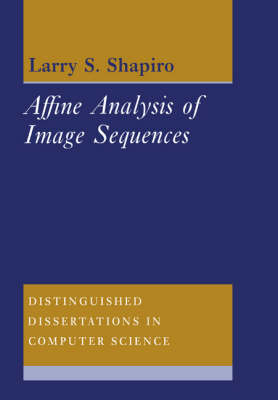
Affine Analysis of Image Sequences
Seiten
2005
Cambridge University Press (Verlag)
978-0-521-01978-1 (ISBN)
Cambridge University Press (Verlag)
978-0-521-01978-1 (ISBN)
Computer vision is a rapidly growing field which aims to make computers 'see' as effectively as humans. In this book, based on his award-winning thesis, Dr Shapiro presents a new computer vision framework for interpreting time-varying imagery.
Computer vision is a rapidly growing field which aims to make computers 'see' as effectively as humans. In this book Dr Shapiro presents a new computer vision framework for interpreting time-varying imagery. This is an important task, since movement reveals valuable information about the environment. The fully-automated system operates on long, monocular image sequences containing multiple, independently-moving objects, and demonstrates the practical feasibility of recovering scene structure and motion in a bottom-up fashion. Real and synthetic examples are given throughout, with particular emphasis on image coding applications. Novel theory is derived in the context of the affine camera, a generalisation of the familiar scaled orthographic model. Analysis proceeds by tracking 'corner features' through successive frames and grouping the resulting trajectories into rigid objects using new clustering and outlier rejection techniques. The three-dimensional motion parameters are then computed via 'affine epipolar geometry', and 'affine structure' is used to generate alternative views of the object and fill in partial views. The use of all available features (over multiple frames) and the incorporation of statistical noise properties substantially improves existing algorithms, giving greater reliability and reduced noise sensitivity.
Computer vision is a rapidly growing field which aims to make computers 'see' as effectively as humans. In this book Dr Shapiro presents a new computer vision framework for interpreting time-varying imagery. This is an important task, since movement reveals valuable information about the environment. The fully-automated system operates on long, monocular image sequences containing multiple, independently-moving objects, and demonstrates the practical feasibility of recovering scene structure and motion in a bottom-up fashion. Real and synthetic examples are given throughout, with particular emphasis on image coding applications. Novel theory is derived in the context of the affine camera, a generalisation of the familiar scaled orthographic model. Analysis proceeds by tracking 'corner features' through successive frames and grouping the resulting trajectories into rigid objects using new clustering and outlier rejection techniques. The three-dimensional motion parameters are then computed via 'affine epipolar geometry', and 'affine structure' is used to generate alternative views of the object and fill in partial views. The use of all available features (over multiple frames) and the incorporation of statistical noise properties substantially improves existing algorithms, giving greater reliability and reduced noise sensitivity.
1. Introduction; 2. Corner extraction and tracking; 3. The affine camera and affine structure; 4. Clustering using maximum affinity spanning trees; 5. Affine epipolar geometry; 6. Outlier rejection in an orthogonal regression framework; 7. Rigid motion from affine epipolar geometry; 8. Affine transfer; 9. Conclusions; Appendices A. Clustering proofs; B. Proofs for epipolar geometry minimisation; C. Proofs for outlier rejection; D. Rotation matrices; E. KdV motion equations; Bibliography; Index.
| Erscheint lt. Verlag | 15.9.2005 |
|---|---|
| Reihe/Serie | Distinguished Dissertations in Computer Science |
| Zusatzinfo | 118 Line drawings, unspecified |
| Verlagsort | Cambridge |
| Sprache | englisch |
| Maße | 170 x 245 mm |
| Gewicht | 371 g |
| Themenwelt | Informatik ► Grafik / Design ► Digitale Bildverarbeitung |
| Informatik ► Theorie / Studium ► Künstliche Intelligenz / Robotik | |
| Technik | |
| ISBN-10 | 0-521-01978-8 / 0521019788 |
| ISBN-13 | 978-0-521-01978-1 / 9780521019781 |
| Zustand | Neuware |
| Haben Sie eine Frage zum Produkt? |
Mehr entdecken
aus dem Bereich
aus dem Bereich
Modelle für 3D-Druck und CNC entwerfen
Buch | Softcover (2022)
dpunkt (Verlag)
34,90 €
Methoden, Konzepte und Algorithmen in der Optotechnik, optischen …
Buch | Hardcover (2024)
Hanser (Verlag)
39,99 €


